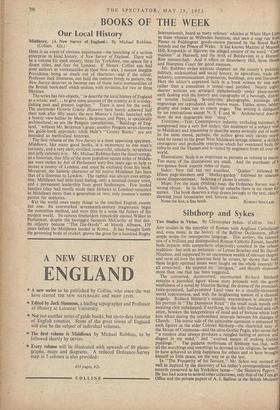BOOKS OF THE WEEK
Our Local History
Middlesex. (A New Survey of England.) By Michael Robbins. (Collins. 42s.) HERE.is an event of obvious importanceāthe launching of a serious enterprise in local. history, A New Survey of England. There will be a volume for each county, three for Yorkshire, one apiece for a dozen cities, and four for London. If Messrs. Collins can find sixty authors as workmanlike as their firstāalas, I cannot imagine Providence being so much out Of characterāand if the editor, Professor Jack Simmons, can hold the authors firmly to pattern, the New Survey deserves to become one of those basic commodities of the British bookshelf which endure, with revisions, for two or three lifetimes.
The series has two objects, " to describe the local history of England as a whole; and ... to give some account of the country as it is today, linking past and present together." There is need for the work. The enormous Victoria County Histories have barely achieved half their task after fifty years; the new Murray's Guide, launched with a breezy view-halloo by Messrs. Betjeman and Piper, is specifically architectural; so are the Penguin compilations, "Buildings of Eng- land," without Mr. Betjeman's grace; another Penguin series chooses the guide-book approach; while Hale's "County Books" are not intended as methodical histories.
The first volume of the New Survey is a most appetising specimen. Middlesex, like many good books, is a monument to one man's curiosity, and a very alert, civilised, resourceful, scholarly, scrupulous and jolly curiosity it is. Mr. Michael Robbins faces the disadvantage, as a historian, that fifty of the most populous square miles of Middle- sex were stolen by Act of Parliament sixty-five years ago to help to invent a county of London, and must be excluded from his book. Moreover, the historic character of his native Middlesex has been that of a doormat to London. The capital was always over-attrac- tive; Middlesex had little local feeling, only a nominal county town, and a permanent leadership from great landowners. Few landed families (they had mostly made their fortunes in London) remained in Middlesex more than a generation or two; only yeomen's names persist for centuries.
Vet the world owes many things to the smallest English county but one. Its overworked seventeenth-century magistrates begat the committee method, and were thus in a sense the fathers of the modern world. Its riotous freeholders repeatedly elected Wilkes to Parliament, despite the bewigged Senators McCarthy of that day. Its infantry became "The De-Hards" at bloody Albuera, 139 years before the Middlesex landed in Korea. It has brought forth the governing body of cricket, grown the grass for a hundred Rugby Internationals, heard as many referees' whistles at White Hart Lane as train whistles at Wffiesden Junction, and seen a stag run from Pinner to Paddington goods-station pursued by the Royal BuckĀ° hounds and the Prince of Wales. It has known Mazzini at Muswell Hill, ICropotkin at Harrow, the alleged creator of the word "Con? munism" at Hanwell, and the birth of Bolshevism in a HornseY Rise mission-hall. And it offers us Strawberry Hill, Syon House and Hampton Court for good measure. Mr. Robbins writes separate chapters on the county's political, militarsy, ecclesiastical and social history, its agriculture, trade and industry, communications, population, buildings, arts and literature, Here the editor's expressed faith in a book written by One man rather than a committee is testedāand justified. Nearly eightY shorter sections are arranged alphabetically under place-names, each dealing with the history and topography of a borough, district or notable building. Seventy-five photographs, paintings and engravings are reproduced, and twelve maps. Tables, notes, bibli0. graphy and index run to ninety pages. The writing is disfigured by no contractions except N, S, E and W. Architectural descripā¢ tions do not degenerate into "shop." Criticisms.āText: Contemporary industry, excluding transport, le compressed into a very fevb inches; this treatment of a subject vital to Middlesex and interesting to describe seems seriously out of scale, In the same mood, perhaps, the author gives only eleven words (and no name) to the great West Middlesex sewage scheme, a skilled, courageous and profitable enterprise which has sweetened both the suburbs and the Thames and is visited by engineers from all over tIlt world.
Illustrations: Scale is as important to pictures as volume to music, Too many of the illustrations are small. And the purchaser of 3 two-guinea .book expects mere of them.
Index: Very full but not excellent. "Quaker" followed .bY fifteen page-numbers and "Market-garden, " followed by nineteen cause disappointment. Indexing of plates is erratic. Maps: For the main (folding) map, the Ordnance Survey was a wrong choice. In its black, built-up suburbs there is no room for names. The book deserves a map drawn lovingly to the text, clearlY showing local boundaries and historic sites.


































 Previous page
Previous page